The Unicorn, Stepples Street, Catchpole's
brewery,
Talbot's mineral water, Pain
& Bayles' Turret Works
The Unicorn Inn,
2-4 Orwell Place
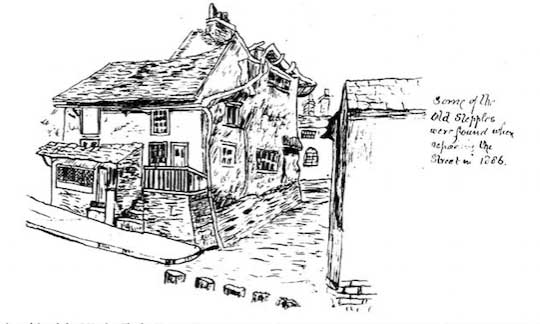
Above: 'Some of the Old Stepples were found when repairing the Street
in 1886' from G.R. Clarke's History
(see Reading list).
The attractive frontage of The Unicorn at the corner of
Orwell Place
(formerly
Stepples Street to commemorate the stepping stones, used by walkers to
avoid
flood waters from The Wash, or Upper
Orwell
Street) and Foundation Street obviously deserved a
proclamation
of its importance. These huge upper case slab serif letters (complete
with
square full stop) stand in relief and have been preserved long past the
existence
of the Unicorn itself. The carpet shop which used to occupy the ground
floor
has been succeeded by a number of businesses. The Unicorn was a hotel
which
was
part of the sizeable brewery behind it dating to 1886. However, a brewer possibly on this site is listed as early
as 1839
with Nathaniel Catchpole & Co. listed as owners in 1865. The
whole group of impressive Unicorn buildings
(which included a small theatre, we're told) embody an important part
of
Ipswich history: brewing. We have already
discovered that
brewing took place behind the Rose
&
Crown,
not to mention the historic Tolly
Cobbold
brewery on Cliff Quay - no
longer brewing beer and the with that building looking for a new
purpose in 2013. There was also a Steam Brewery built and run by
Charles Cullingham in 1856 and bought by the Tollemache
brothers in 1888 which was opposite the Unicorn, on the site
of the car park behind the former Woolworth store. There were many
other small breweries throughout the town over the decades.
The Unicorn brewery
and public house were owned by Nathaniel Catchpole and Co. Ltd until it
was bought
in 1923, along with several other hostelries in the Ipswich area
(including the Coach
& Horses), by
Tollemache jointly with Cobbold's – long before they became Tolly
Cobbold in
1957 – and the brewery was closed in the 1960s when production
was moved
to Cliff Quay brewery. There is a suggestion that the Unicorn Brewery
ceased brewing in 1923 and became a mineral water works (see below). The Unicorn Inn at 2-4 Orwell Place pulled its
last pint
in 1977.
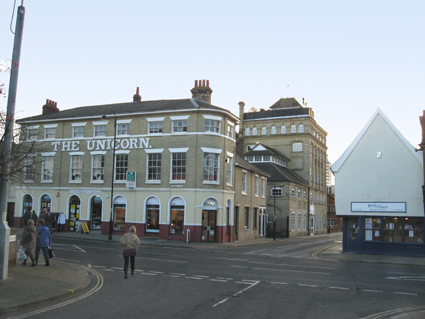 2012
images
2012
images
Above: a view
in 2012 from Cox Lane down Foundation
Street of the Orwell Place 'THE UNICORN.'
frontage and brewery rising behind it.
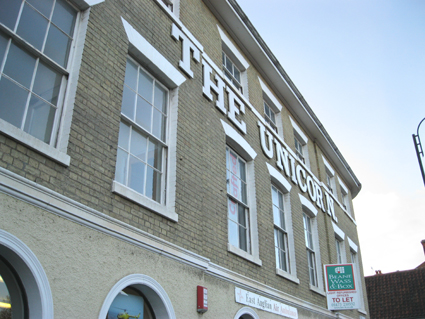
The Unicorn Inn is Listed Grade II:
'An early-mid C19 grey gault brick building with a stuccoed ground
storey and a quadrant corner on Foundation Street. 3 storeys and
cellars. 9 window range ovrerall (1 on the quadrant corner and 1 on
Foundation Street). The windows are double-hung sashes with glazing
bars, in plain reveals with stuccoed flat arches. A stucco band extends
across the front at 2nd storey window sill level and a raised band
terminates the stuccoed ground storey which has semi-circular arched
windows and doorways. The east end, of 2 window ranger breaks forward
slightly and the quadrant corner is slightly recessed. At the east end
there is a 2 storeyed extension, of 1 window range. Roofs slate.
Listing NGR: TM1663244372'
Below: we see
the Unicorn, with lettering proudly in
place, in 1897,
the
flags flying for the Diamond Jubilee of Queen Victoria. All the
buildings
to the left have gone and the very narrow Stepples Street opened up.
The
junction
to the left (below the awnings) which is opposite the mouth of
Foundation
Street is Cox Lane, when it led to dense housing of the poorest
quality:
Permit Office Street, Barclay Street and Union Street . The Unicorn
brewery
closed in 1923, but 'The Unicorn' on Orwell Place remained as a public
house until 1977. The
Suffolk CAMRA site (see Links,
also on that
page see our Reading List - James, T.: 'Ipswich inns, taverns and
pubs') provides a list of many of the landlords of the inn.
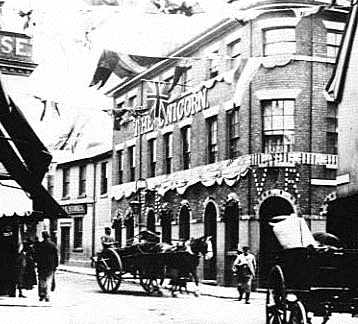
This photograph shows the Foundation Street face of the
Unicorn corner featuring a typical cast iron street nameplate. See our Street nameplates page for further
examples.
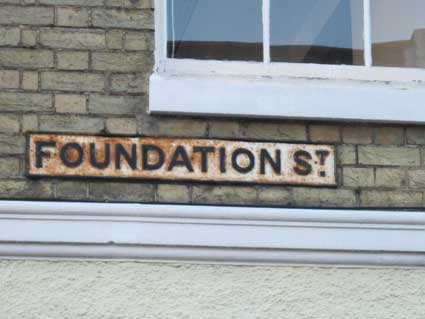
The Unicorn Brewery, Foundation Street
Below: updating the story to
the late snows of March,
2005 (you can
see the falling flakes on the images). This block with its rooftop
lantern was used as offices/studios in the 1980s/1990s, then left
largely empty for years. The building has been cleaned
and extended during major refurbishment as flats; this 'olde worlde'
sign
was
added high above and facing the Foundation Street car park:
'THE ... UNICORN ... BREWERY'
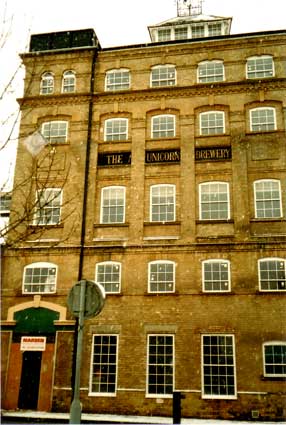 2005
images
2005
images
From a graphic design point of view, the centering of
each word within its discrete black section is justifiable (no pun
intended) but makes the definite article on the left feel disconnected
with the rest of the name. The
postmodern twist that the building – now so proudly named in condensed,
serif, gold capitals on a black ground – ceased to be brewery many
years ago may have escaped the developers. Eminent
brewery architect William Bradford designed both Cobbold's Cliff
Quay and
Catchpole’s Unicorn breweries.
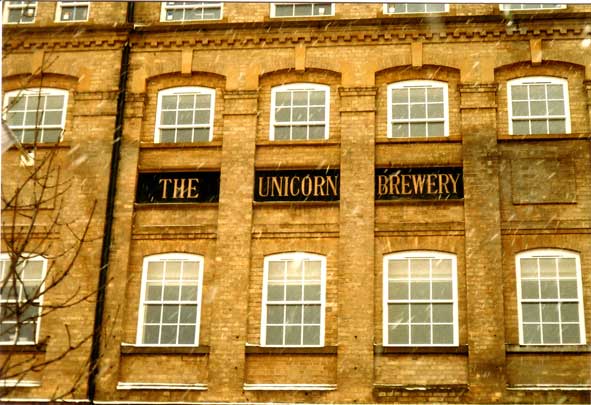
The Brewery Yard,
Foundation Street
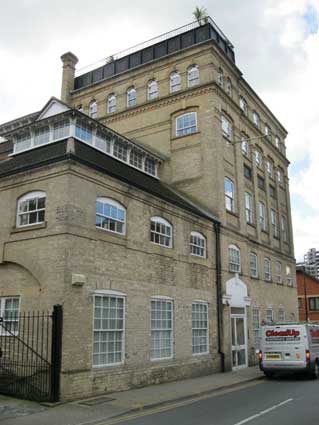
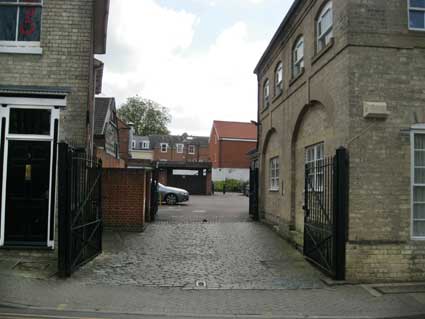 2013 images
2013 images
The original gates still hang by the cobbled entrance from Foundation
Street, which is rather satisfying. The interesting architectural
details, shown below, not seen from the road are worth a look. At the
very top are
plants visible above the plating of the original water tank (compare
with the Tolly Cobbold brewery
tank). The octagonal brickwork is explained by the period
photograph on our Martin & Newby
page.
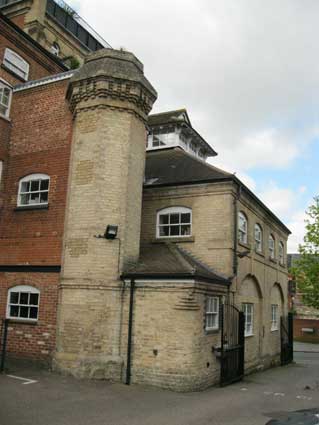
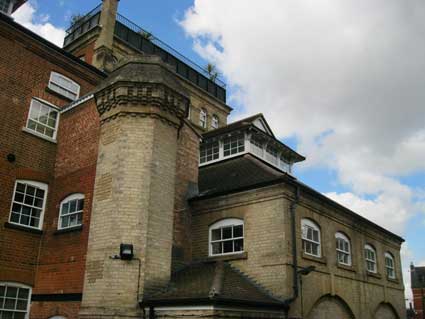
The Unicorn and the Blackfriars Church
site
The proximity of the rear of the Unicorn Brewery to the remains
of the church of the Blackfriars monastery to the south
is significant. While some of the row of stone arches shown on our Foundation Street page are original and in situ, others are said to be
'restorations'. More traces of the monastery survive in the cellars of
the former heating engineer's premises in the old Cathchpole's Unicorn
Brewery. We would love to see some photographs of these remains.
Ipswich Blackfriars was founded in 1263, following the gift to them by
Henry III of a piece of land which he had purchased alongside the Town
Defences on the east side of the town. In 1265 a further piece of land
was granted to them by the Crown and construction of their Church
began. Further land was acquired steadily until the mid-14th century,
by which time their Precinct covered most of the area between
Foundation Street, Orwell Place, Lower Orwell Street and Star Lane. It
is no wonder that traces of the monastery exist below the much later
brewery. Much of the church site was covered up over the centuries and
only saw the light of day due to the labours of pioneering
archaeologist, Nina Frances Layard, to
whom an Ipswich Society blue
plaque, fixed to the Unicorn wall overlooking the church
site, was dedicated in 2016.
Talbot's mineral water
[UPDATE 15.6.204: "I happened
to see your website about the old brewery and was amazed that you had
so little information on it.
My father was Cyril Catchpole who had a sweet shop on St Margaret's
Plain in Ipswich in the early 1920s. One day a traveler for a lemonade
manufacturing company suggested to him that selling lemonade was to
become a popular proposition and he ought to buy one. Being interested
in anything new and after being let down by his last venture into
producing the first "Potato Crisp" at a factory in Lowestoft
later taken over by Smiths, he purchased a machine. As promised this
turned out to be an instant success. Lack of space at the back of the
shop made him look out for larger premises and he turned his eye onto
the Unicorn Brewery site vacated by his family.
With the financial backing of a few worthy rich citizens he founded
Messers Talbot and Co. Ltd., Mineral Water Manufacturers, 3 Foundation
Street, Ipswich. He also inherited the old brewery carts and Suffolk
horses which were stabled in St Helens, about 100 yards on the left
past Majors Corner. In 1932 I used to go there to see the horses and
climb on the carts. He bought his mares from country pubs which all had
stables at the back of their premises where they kept a mare that was
serviced by the traveling stallion.
He had a store and office at Leiston and a wagon and pair would take
the crates over there and that was a whole day's job. Getting to
Felixtowe was a tricky journey because the road at the Bucklesham turn
was very sandy and the carts got stuck. A pair of horses stood there to
help get them over so they could get on their way again. The carts used
to visit most of the pubs in the district to deliver the lemonade,
ginger ale, tonic water, cider (under license) and of course Smith's
Crisps in large tins. They also had a wholesale business in
tobacco and cigarettes and these would be delivered at the same time.
Eventually the horses gave way to small lorries and in about 1938 he
purchased a 6-tonner in time for the Royal Agriculture Show when it was
held on the London Road on the left opposite the Chantry Park.
During the war he managed to get the franchise from Pepsi Cola to
provide drinks for all the American bases round about and this assured
the continuance of the enterprise until the end of the war. I was not
long after the war that Talbot & Co. Ltd. was taken over by
Cottrill & Cantrill of Colchester who, despite promises to
keep the factory going, very soon closed it down. The rest is
history.
I hope this information will be of some use or interest to you. If I
can be of any further help, please get in touch. Yours sincerely,
Richard Catchpole." Many thanks to
Richard for this "horse's mouth" information from a family member.]
[UPDATE 31.10.2016: We only
recently came across Kim Jennings' site, Avatus
Research, where the fuller
story of the Talbot company is detailed. "Although Mr Catchpole claims
that his father founded Talbot and Co., (which is not the case) it is
quite possible that he took over the business and moved the company to
the premises in Foundation Street." See
more from this source below.]
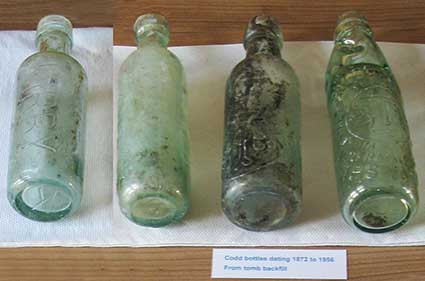 2016 image
2016 image
The above photograph shows old mineral water bottles taken from
tomb backfill during the excavations st St
Mary-At-Quay Church. The accompanying commentary displayed during
the Grand Opening used material from the Avatus Research website
mentioned above. We acknowledge Kim's excellent research here and
present an edited version:-
Mineral water originated from health spas around Europe. It was thought
that these waters had beneficial properties and it became very
fashionable to travel to one of the spa towns, such as Bath, to ‘take
the waters’. Such trips are described in the novels of Jane Austen.
Mineral water suppliers at The Great Exhibition in London in 1851
introduced their product in bottles; by the end of the 19th century
mineral water was accessible to almost anyone.
[UPDATE 18.5.2021: Ipswich is
a fascinating place, perhaps like many others. Just when you think
you've got most of a story – for example, Talbot's mineral water
business – it turns out that a friend not only has a fine collection of
Talbot bottles, but that Mr Talbot himself used to live in his house.
Many thanks indeed to Chris Wiltshire for telling me the tale of the
Talbot residency in Burlington Road, but also that he unearthed in the
garden kiln spoils in a pit: salt glazed fragments of ginger beer
bottles fused together and broken. Chris supplied these excellent
photographs.]
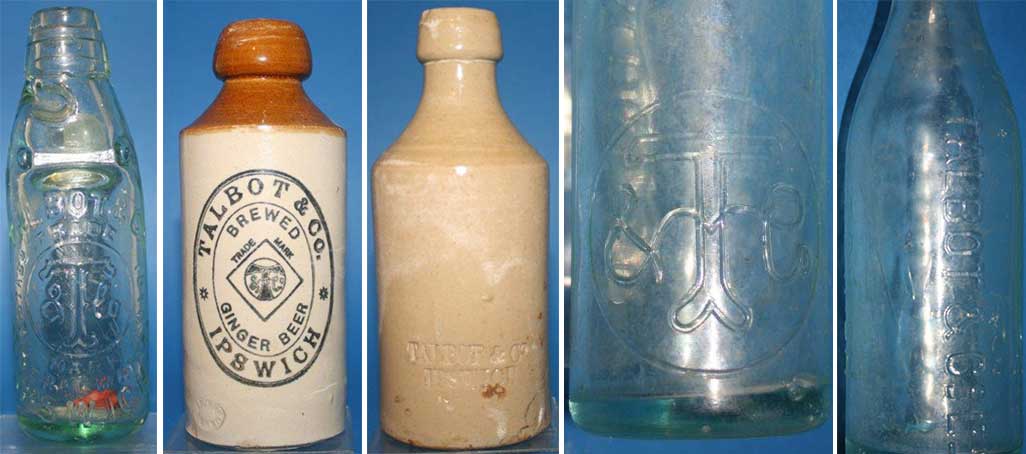
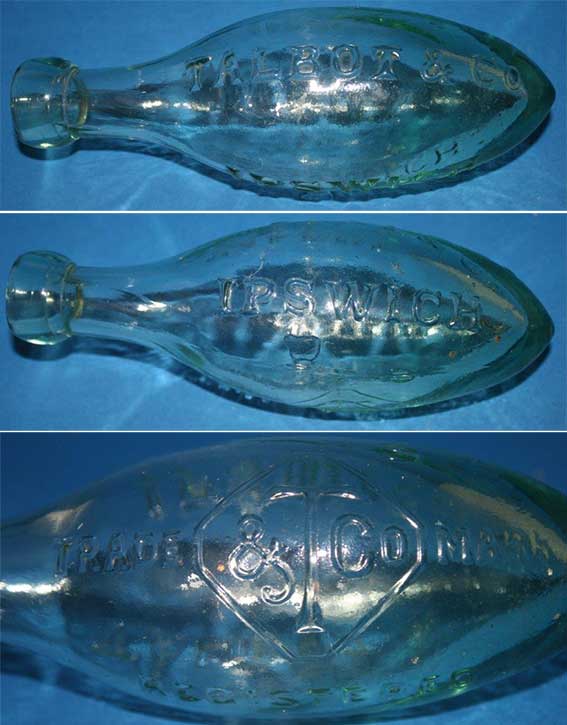 2021 images courtesy Chris Wiltshire
2021 images courtesy Chris Wiltshire
The three lower images show a rather odd egg-shaped bottle which
lack a flat bottom, in order to stand upright. It features in raised
characters on the glass: 'TALBOT & CO.', 'IPSWICH',
'TRADE T&CO MARK'
with 'REGISTERED' beneath. See below for an explanation
of the shape.
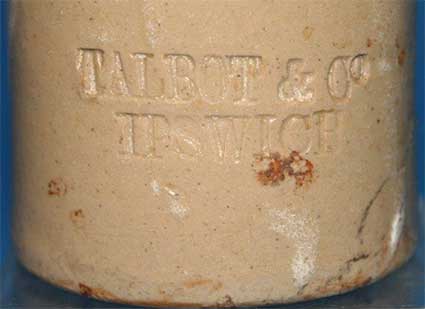
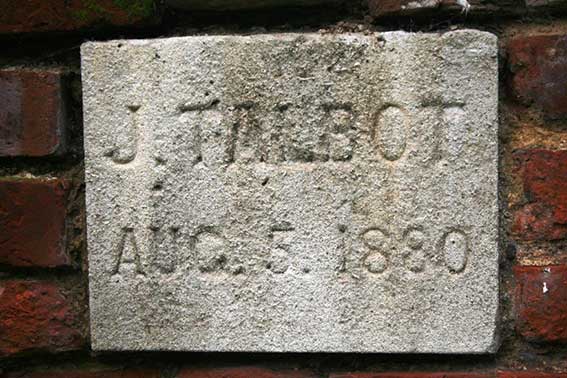 'J. TALBOT
AUG. 5. 1880'
'J. TALBOT
AUG. 5. 1880'
Torpedo bottle
By an odd coincidence, on the same day, the fragment
of an egg-shaped drinks bottle shown below was dug out of the topsoil
of Brickmakers Wood. The first image
shows the 'BOT of 'Talbot'; beneath that is '& Co.'; at top right
is the edge of the diamond-shaped Talbot logo and the word (Trade)
'MARK' with
the end of the word (Regis)'tered'. The patina on the glass is caused
by it being in the soil for a long time. The thickness of the glass is
intended to contain the pressure of its carbonated contents.
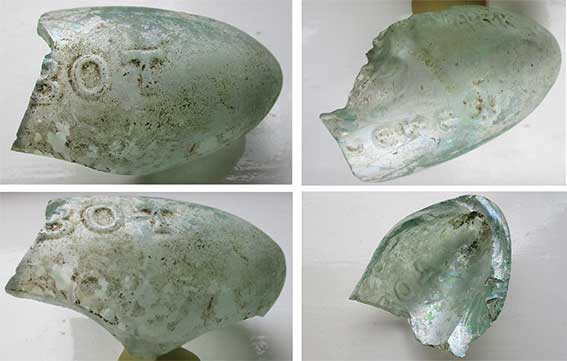 2021 image courtesy Mandy Gaylard
2021 image courtesy Mandy Gaylard
So why this strange, impractical shaped bottle? 'Joseph Priestly
discovered how to make carbonised mineral water in 1772. It was
prepared by dissolving carbon dioxide in water and was originally
regarded as having medicinal properties. By 1860, it had become easier
to manufacture and was being flavoured with fruit syrups, lemons and
limes. It had lost its medicinal associations and was being retailed by
grocers and wine and spirit merchants, as well as chemists. At first
the new drink was stored in earthenware bottles, but the gas escaped
through the skin and the drink became flat. Manufacturers switched to
glass bottles. However, corks were still used to seal the carbonised
mineral water drinks, and if they were allowed to dry out they tended
to loosen which allowed the gas to escape. If the bottles were stored
on their side, this was less likely to happen, but shopkeepers were
reluctant to store them this way. In 1814, William Hamilton introduced
the egg shaped or torpedo bottle, which gave shopkeepers little option
but to store them on their side due to the rounded base. Hamilton
bottles did not come into general used until the 1840s, but once they
did they remained popular for many decades.' (Information from the
Future Museum of South West Scotland, www.futuremuseum.co.uk.)
Below: some industrial archaeology: remnants of kiln wasters, some of
them fused together with melted glaze, dug out of John Talbot's old
garden. Lettering found impressed into the stoneware includes 'THE
EASTERN COUNTIES SODA WATER WORKS IPSWICH' and [TA]LBOT & CO
[IP]SWICH'.
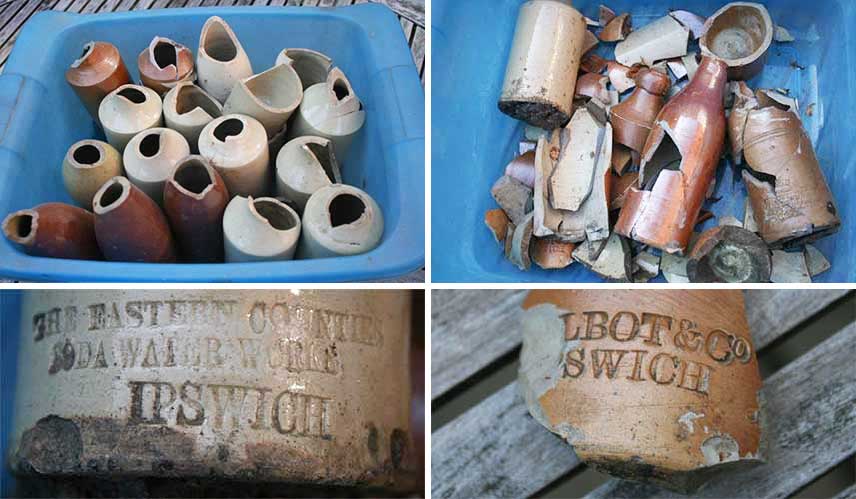 2021 image courtesy Chris Wiltshire
2021 image courtesy Chris Wiltshire
Ipswich as a spa town
In the second half of the 17th century, a spring was discovered on St
Georges Street. This would have been one of the many springs which
still surround the town; perhaps the location close to the town centre
and to the (now lost) Church of St George made it of some importance.
However, Ipswich already had a spa: the ‘Ipswich Spa Waters’ in St
Margarets Green (see Water in Ipswich for
much more on this). The idea of opening another spa was rejected. Years
later the Talbot family may have seen a trade opportunity just
around the corner which was to be the making of them.
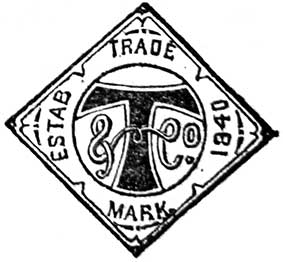
In 1851, the Talbot family were living in Crown Street. John Talbot
(aged 50), a Dyer, was born in Norwich; he was living there with his
wife Mary and six children, the eldest of whom was his son John aged 21
who was also working as a Dyer. In 1855’s White's Directory, the two
were actually advertising their services in three sections:
Booksellers, Binders, Printers and Stationers; Dyers and Scourers;
Ginger Beer and Soda Water Makers. An interesting mix of occupations.
By the time of the census in 1861, the family had moved into nearby 12
St Georges Street. John is listed as a Silk Dyer and his younger son
William was a Soda Water Maker. John junior lived in Crown Street with
his new wife and his two sisters Pauline and Levina. He is listed as a
Book Seller and Soda Water Maker employing 6 men and 2 boys.
The drinks manufacturing was successful and the family concentrated on
that. By 1881 John junior and Harriet were living comfortably and were
able to hire a servant and John had doubled his workforce. By 1885 the
business had expanded and another outlet had opened in Saxmundham. John
moved from the town centre to the sizeable Plantation House in
Burlington Road (shown on our Named
buildings page), for many years the home of noted historian, Dr
John
Blatchly. Moving here was a step up the social ladder for John Talbot
and a clear indication of a successful businessman.
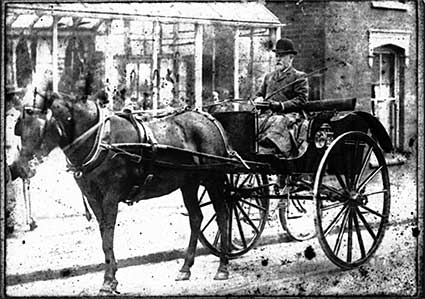 Image courtesy Chris Wiltshire
Image courtesy Chris Wiltshire
Above: John Talbot looks a fine
fellow in his chaise and bowler hat.
By 1922 Talbot's had opened up another branch in Colchester,
there were
now four branches serving two counties and perhaps beyond. Although the
advertisements for Talbot & Co maintain that the company was
established in 1840 (see the trade-mark), this is very unlikely. John
Talbot senior does not appear in White's
Directory of 1844, also
he states that his occupation in 1841 was a Dyer as it was in 1851.
John junior was only 12 in 1841 so would not have been doing any
business. So it appears that there may have been a little exaggeration
when making the company trademark.
Well into their eighties, Harriet passed away on 1 April 1925 and John
followed just a few weeks later on 19 May. The couple never had
any children and their estate worth over £25,000 (approximately
£750,000 in today's money) went to probate. By 1933 Talbot Mineral
Water were advertising as Talbot & Co Ltd, mineral water and
cordial manufacturers; suppliers of A J Caley & Sons Ltd. Mineral
waters; manufactory and office: Unicorn Works, Foundation Street,
Ipswich and at Colchester and Saxmundham. They had moved their head
office and works to Foundation Street which was also the site of the
Unicorn brewery and inn and had ceased trading in Felixstowe and
Stowmarket. A few years later they had expanded their services to
include the wholesale selling of biscuits and tobacco. Talbot
advertised their product on the back page of the souvenir programme for
the Third Ipswich Ideal Homes and Trades Exhibition in February, 1938.
But the writing was on the wall for Talbot's...
Oddly, a separate Talbot Mineral Water Company thrived
in Gloucester, founded in 1845, and a
ghost sign survives there.
[UPDATE
13.8.2023: 'With regards to the John Talbot section I read in your very
informative article I wondered if this information would be of
interest. A family member used to work in the Arlington on Museum
Street, Ipswich and it was from there that this [advertisement] was
acquired. It has very light water damage to the wooden back and light
rust patina to the tin frame but is excellent condition and is said to
come from the bar of the Arlington. We also have family that worked for
Nick Wiggin, as mentioned in the article below the John Talbot piece.
Regards, Gary Gooderham'. Many
thanks to Gary for getting in touch with the charming images and
information. We would estimate that the advertisement dates to 1940s to
1950s.]
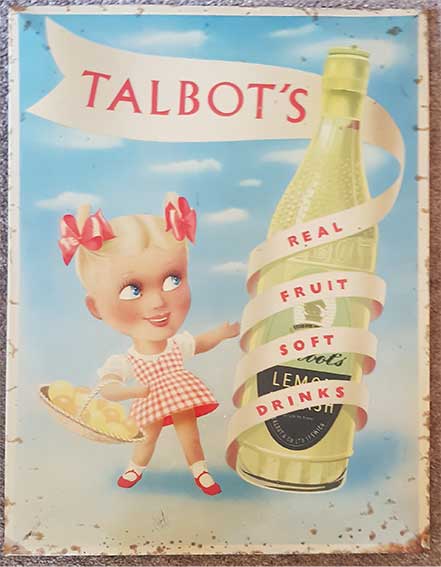
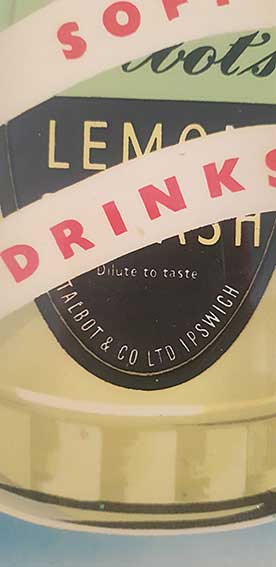 Images courtesy Gary Gooderham
Images courtesy Gary Gooderham
Pain & Bayles Turret Works
Nick Wiggin, of the famous local Wiggin
& Son chemist, sent these images of stoneware soda water
flagons.
'PAIN
&
BAYLES
P&B [on flag]
TRADE MARK
TURRET WORKS
IPSWICH
WRIGHTSON'S
PATENT'
There would have been a spigot or
tap attached to the lower outlet. The company clearly
extended their business to Felixstowe, as
that place appears with Ipswich on later ginger beer flagons (see the
company details below).
To the right, another example labelled:
'THIS BOTTLE IS THE PROPERTY OF
A. ARDEN
BOTANICAL BREWER
WHITTON
IPSWICH
AND IS NOT CHARGED FOR,
BUT MUST BE RETURNED.
ANYONE ILLEGALLY USING OR
DETAINING WILL BE PROSECUTED'
... which suggests that the
authorities may still be in pursuit of Mr Wiggin. A.
Arden is listed in the 1939 Kelly's
Directory as A. Arden & Co., brewers, 718 Norwich Road. They
may have started in Norwich Road near Barrack Corner. Listed in the
1952 Kelly's Directory as a
'botanical' brewery. (
Information
from Suffolk CAMRA, see Links).
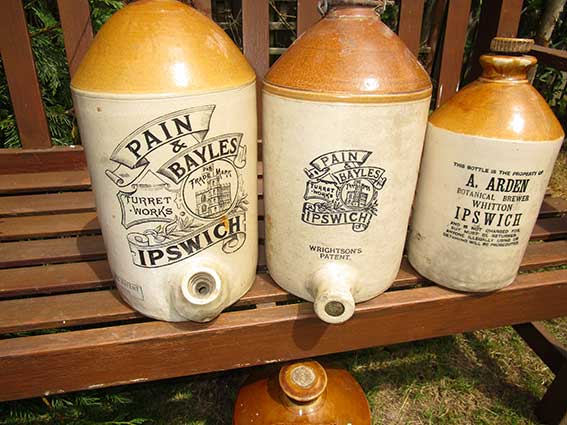 Images
courtesy Nick Wiggin
Images
courtesy Nick Wiggin
And to prove that stoneware containers were versatile, Nick sent this
ink
flagon:
'MAY & CO.
MANUFACTURERS OF
- INK -
AND THE PATENT GIESSEN BLUE
FOR THE LAUNDRY.
43A, LONDON WALL
E.C.'
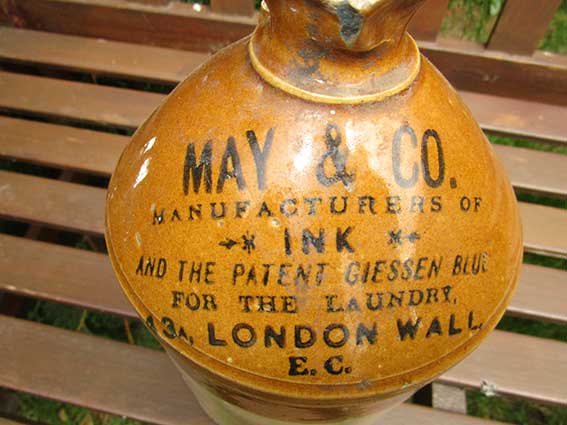
'Pain & Bayles, dispensing chemists, 17 Cornhill; &
mineral watr manufacturers, Turret Works, Turret
lane; & chemists, 4 Hamilton rd. Felixstowe. See advt'
Kelly's Directory (c.1900?)
In another listing, a branch at High Street and King
Street, Walton
(listed as chemists) is shown.
Arthur Pain, Robert Bayles, William Juby and Harry Douthwaite
traded as
chemists, druggists and mineral water manufacturers in
Ipswich from the Turret Works. The
'chemists' connection may be why these bottles came to be in
the Wiggin& Son archive) and High Street and King Street Walton.
The
business was dissolved in 1901. Turret Lane was named after Turret
House which was demolished in 1843. It is a later name for a
house which formed the entrance to Wolsey’s
college in Ipswich (that page has a representation of the house).
The natural harbour of Ipswich attracted early Anglo-Saxon settlers, as
did the number of natural springs influenced
by the geology in the area. A hollowed oak tree well was found in
Turret Lane, dating to c. AD670.
See also our Pubs
&
Off-licences page; plus our page about Water
in Ipswich.
Home
Please email any comments and contributions by clicking here.
Search Ipswich
Historic Lettering
©2004 Copyright
throughout the Ipswich
Historic Lettering site: Borin Van Loon
No reproduction of text or images without express
written permission



 2012
images
2012
images

 2005
images
2005
images

 2013 images
2013 images

 2016 image
2016 image
 2021 images courtesy Chris Wiltshire
2021 images courtesy Chris Wiltshire

 2021 image courtesy Mandy Gaylard
2021 image courtesy Mandy Gaylard 2021 image courtesy Chris Wiltshire
2021 image courtesy Chris Wiltshire
 Image courtesy Chris Wiltshire
Image courtesy Chris Wiltshire
 Images courtesy Gary Gooderham
Images courtesy Gary Gooderham Images
courtesy Nick Wiggin
Images
courtesy Nick Wiggin